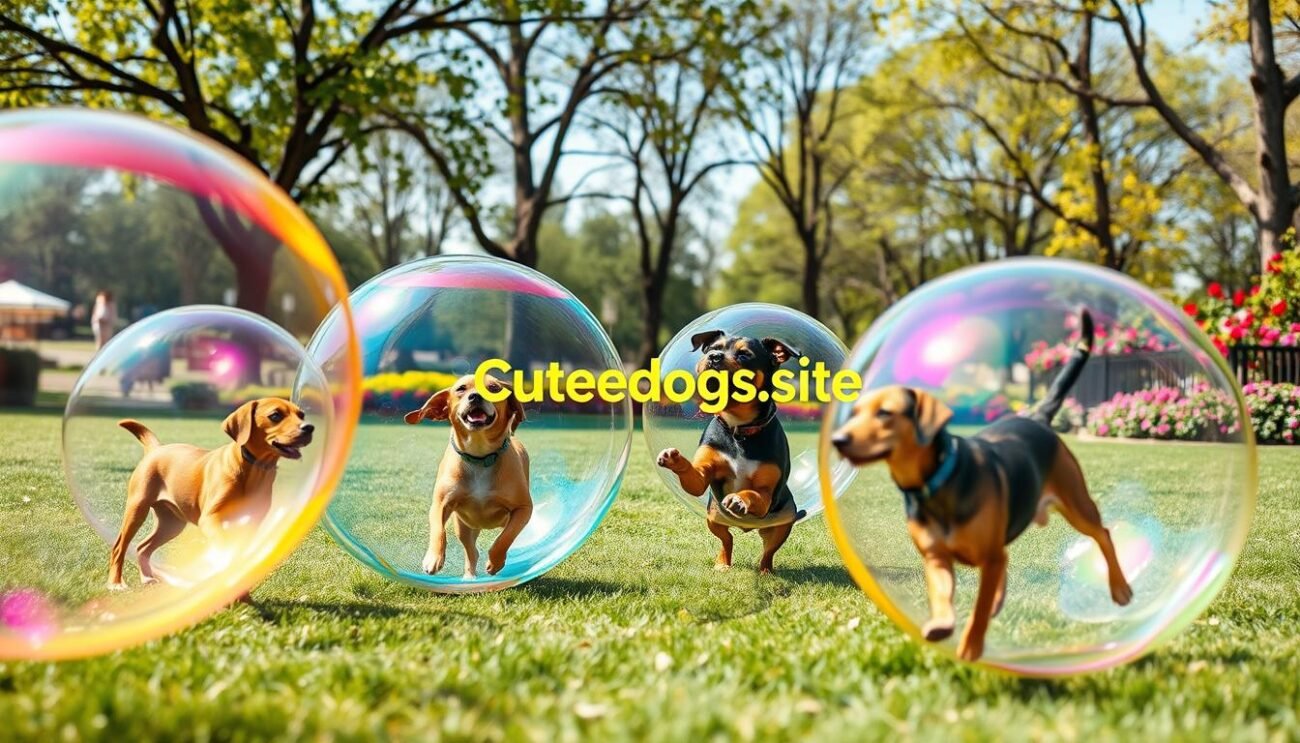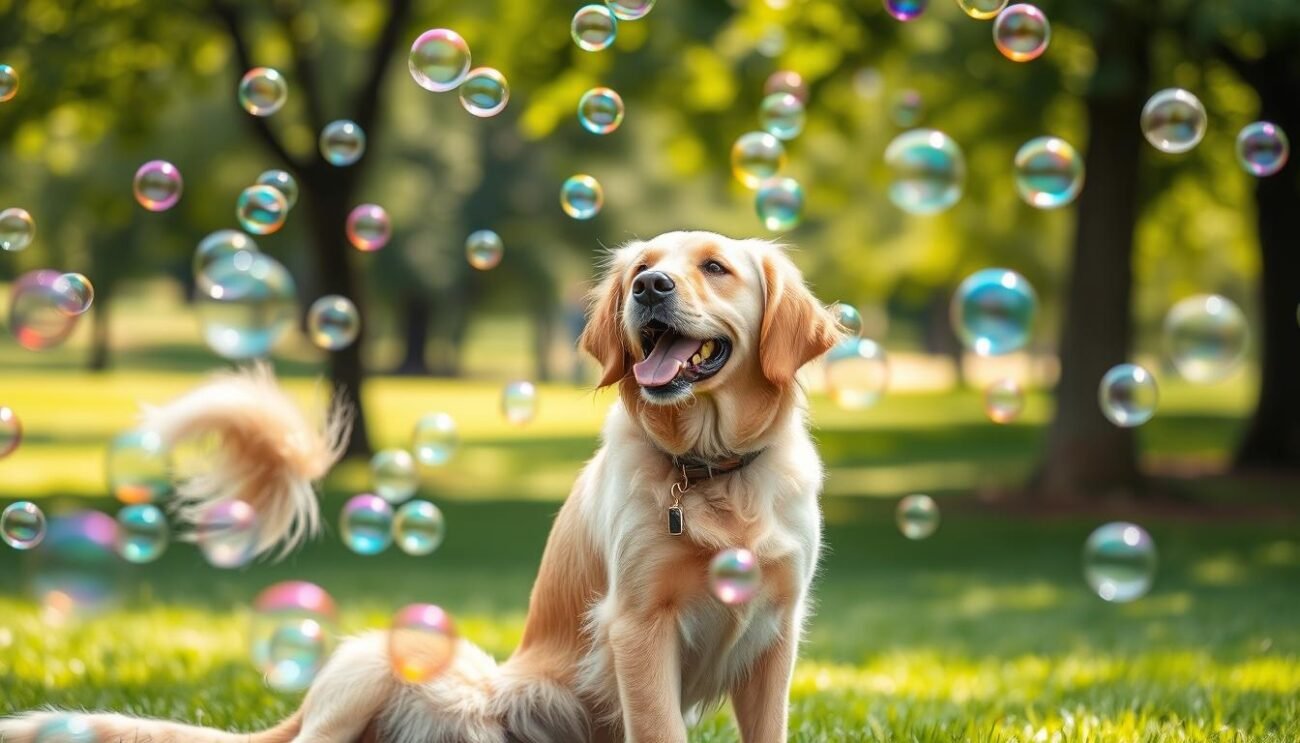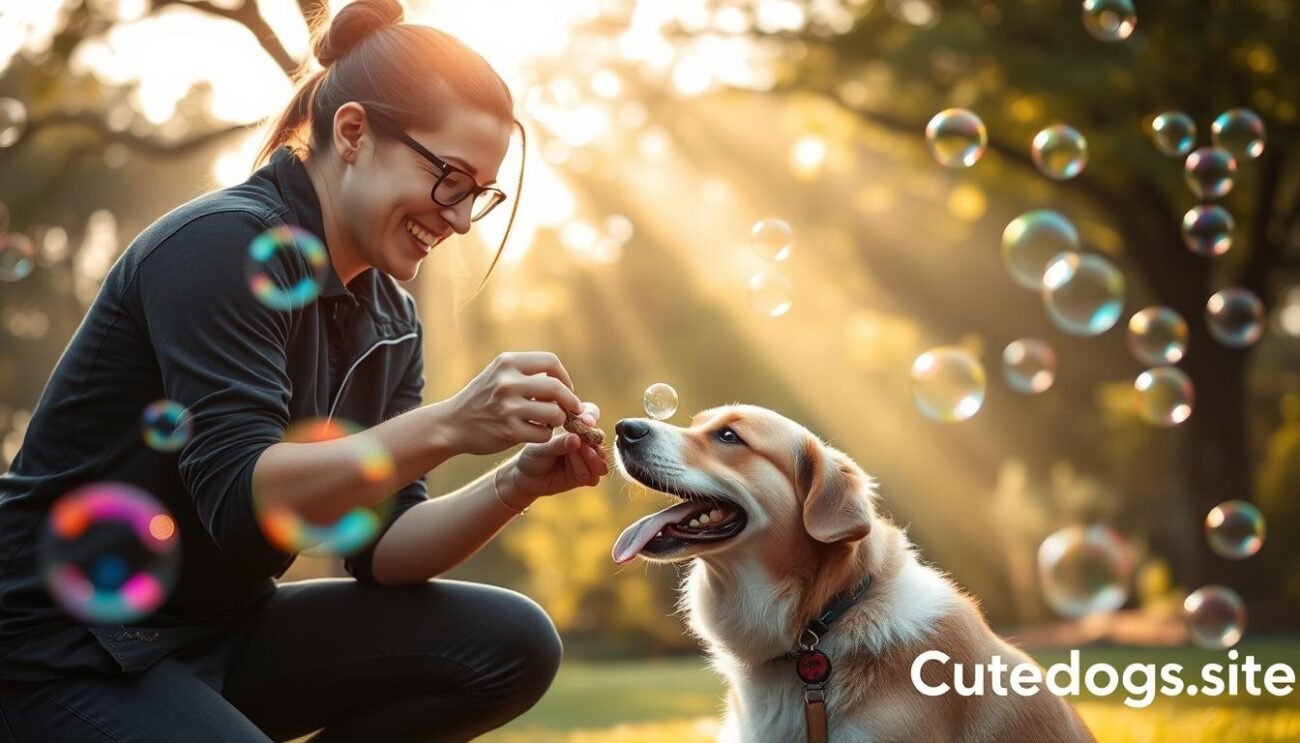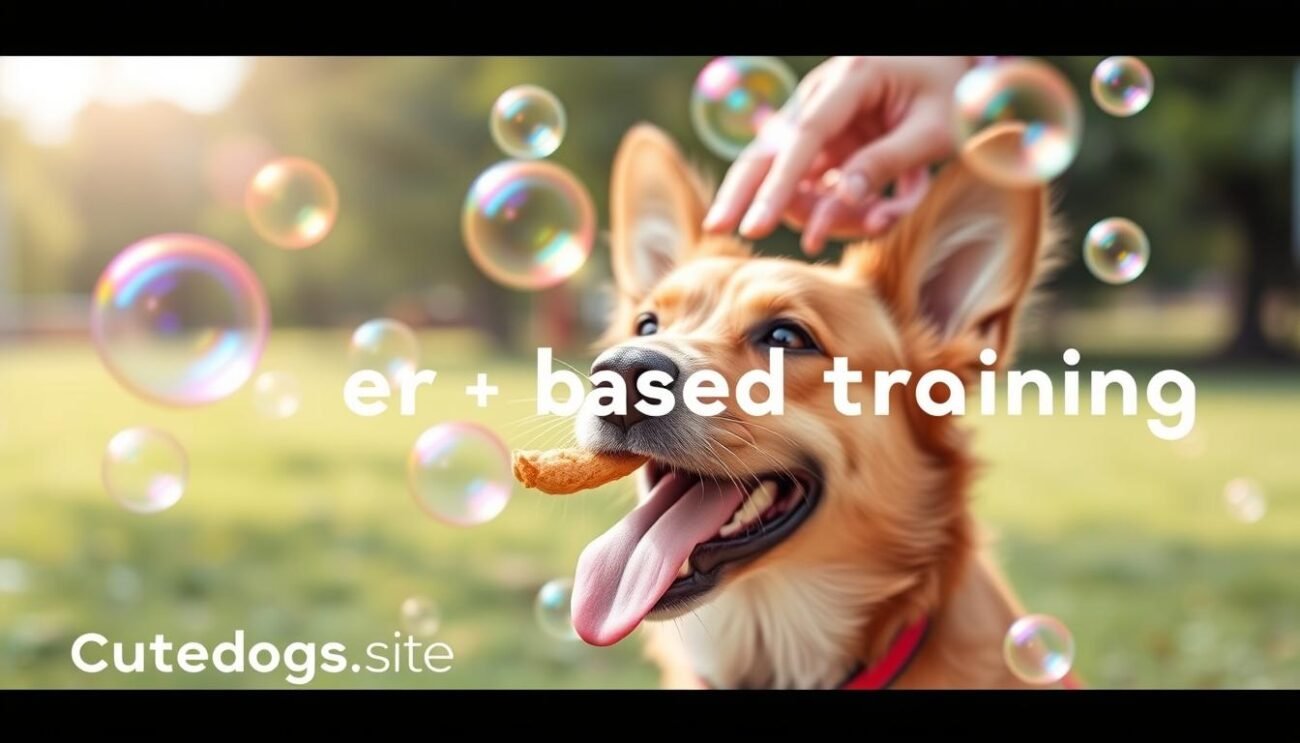A new way to train dogs has come along. It’s called bubble theory dog training. It focuses on positive methods to make dogs and owners happy together.
Bubble theory uses rewards to teach good behavior. It’s based on science that helps you talk to your dog better. This builds a strong bond of trust and respect.
This method is different from old ways that might hurt or punish dogs. Bubble theory is kind and puts your dog’s happiness first. It uses positive rewards and clicker training to teach your dog nicely.

Key Takeaways
- Bubble theory dog training prioritizes positive reinforcement, clicker training, and force-free methods.
- This approach is grounded in the science of operant conditioning and rewards-based techniques.
- Bubble theory offers a humane and ethical alternative to traditional training methods that rely on aversive techniques.
- The focus is on building a harmonious relationship between dogs and their owners through effective communication and trust.
- Clicker training is a cornerstone of bubble theory, providing a clear and consistent way to mark and reinforce desired behaviors.
What is Bubble Theory Dog Training?
Bubble theory dog training is a new way to train dogs. It uses positive reinforcement and operant conditioning. This method shapes good behaviors with rewards and encouragement.
Understanding the Fundamentals of Bubble Theory
Bubble theory says dogs learn best in a safe, controlled space. This “bubble” is made by the trainer. It lets the dog feel safe and want to learn.
The main part of bubble theory is marker signals. These are clicks or words that tell the dog they did something right. This feedback helps the dog know what to do next.
How Bubble Theory Differs from Traditional Training Methods
Bubble theory is different from old ways of training. It doesn’t use punishment or scary methods. Instead, it uses positive reinforcement and behavior shaping.
This way of training makes dogs happy and builds a strong bond with their owners. It’s based on trust and understanding.
The Power of Positive Reinforcement
Bubble theory dog training uses positive reinforcement. It makes dogs want to learn and do well. They get rewards and praise for good actions.
This method is different from old ways that use punishment. Reward-based training makes dogs happy to please you. They learn to do things for treats and love.

Dogs are smart and feel things deeply. They love to be encouraged and positively reinforced. This makes training fun and effective for both of you.
“Positive reinforcement is the key to unlocking your dog’s full potential. It’s a gentle, humane approach that builds trust and fosters a lifelong bond.”
Starting to use positive reinforcement changes everything. It makes your dog happier and more willing to learn. This leads to a better, more loving relationship.
Clicker Training: A Cornerstone of Bubble Theory
Clicker training is a big part of the bubble theory in dog training. It has lots of good points for dogs and their owners. It uses a small device that makes a “click” sound. This sound is a clear way to talk to your dog.
The Benefits of Clicker Training for Dogs
Clicker training is a great way to teach dogs new things. It’s kind and uses rewards to help dogs learn fast and happily. The “click” sound tells dogs what they did right, making them learn better and faster.
This method makes training fun and builds a strong bond between you and your dog. It’s all about working together and having fun.
How to Effectively Use a Clicker in Training
- First, show your dog the clicker and link it with a treat. Click and then give them a treat to show what the sound means.
- Click when your dog does what you want, then give them a treat right away.
- Make the tasks you teach harder, but always use the clicker and a treat to reward them.
- Always be the same with the clicker and stay positive and patient while training.
Using clicker training in your bubble theory helps you talk clearly and positively to your dog. It lets your dog learn and grow with joy and confidence.
Force-Free and Humane: The Ethical Approach
Bubble theory dog training focuses on being kind and gentle. It makes sure your dog is happy and comfortable. It says no to harsh methods that can hurt your dog’s feelings and body.
Why Aversive Methods are Counterproductive
Old ways of training often use punishment or scary sounds. But studies show these methods can make dogs stressed and anxious. They can even cause bad behaviors.
- Using punishment can make it hard to trust your dog. It makes training less fun for both of you.
- Punishment can make dogs act out or even get angry. They learn to fear certain things or commands.
- Even though punishment might stop bad behavior for a bit, it doesn’t fix the real problem. It makes it hard to change behavior for good.
Force-free training and positive reinforcement are better and kinder. They reward good behavior and make learning fun. Your dog will want to learn and work with you, not just do what you say.

“The goal of force-free training is to create a positive, rewarding experience for the dog, where they are motivated to learn and engage with the training process.”
Choosing humane training helps you and your dog trust each other more. It makes training more rewarding and successful for both of you.
Operant Conditioning and Behavior Shaping
Bubble Theory dog training uses operant conditioning and behavior shaping. These methods help change your dog’s behavior. They focus on good actions and build on them.
The Science Behind Bubble Theory Dog Training
Operant conditioning changes behavior through positive reinforcement and reward-based training. Rewarding your dog for good behavior makes them do it more. This is the core of Bubble Theory, making training fun and rewarding.
Behavior shaping breaks down big behaviors into small steps. Rewarding each step helps shape your dog’s actions. This step-by-step method is key in Bubble Theory, helping build complex skills.
| Operant Conditioning | Behavior Shaping |
|---|---|
| Focuses on rewarding desired behaviors Encourages dogs to repeat actions that earn rewards Fosters a positive, motivating training environment | Breaks down complex behaviors into smaller steps Rewards each incremental progress towards the final behavior Allows for gradual refinement and mastery of skills |
Bubble Theory combines operant conditioning and behavior shaping. This method helps change your dog’s behavior in a positive way. It’s based on science and is a powerful training approach.
Bubble Theory Dog Training: A Step-by-Step Guide
Learning bubble theory dog training is easy. It’s all about positive reinforcement and using a clicker. Follow this guide to help your dog grow and learn.
Start by teaching your dog about the clicker. It’s a tool to tell them they did something right. When you click, give them a treat or praise.
- Get your dog used to the clicker by clicking and giving them a treat or praise.
- Use the clicker to mark good behaviors. Start with simple actions and get more complex later.
- Always give treats or praise for good behavior. This makes them happy and eager to learn.
Next, use marker signals to help your dog learn. These signals tell them they did something right. Use them with treats or praise to teach your dog.
| Marker Signal | When to Use | Example |
|---|---|---|
| Verbal Cue | To mark a specific behavior | “Yes!” or “Good!” |
| Hand Gesture | To reinforce a physical command | Raised open palm |
Positive reinforcement is key in bubble theory dog training. Rewarding your dog for good behavior builds a strong bond. It also makes them love learning.

“Bubble theory dog training is not just a method, it’s a philosophy that prioritizes the well-being and happiness of both the dog and the owner.”
Join the bubble theory revolution. See how it changes your dog’s life and your bond with them.
Marker Signals: The Key to Effective Communication
Good communication is key in dog training. Marker signals, like the clicker, are very important. They help you give clear feedback to your dog and teach them new things.
Understanding and Using Marker Signals Correctly
Marker signals, like the “click” of a clicker, connect the dog’s actions to rewards. They tell the dog they did something right. This lets you give them a treat or praise right away.
To use marker signals well, teach your dog to link the sound to good things. Start by clicking and then giving a treat. This shows them the sound means a reward is coming. After they learn this, use the marker signal to show them exactly what you want.

Using marker signals in your training can really help your dog learn. They get clear messages and rewards right away. This makes them better at following commands and builds a strong bond with you.
Motivational Training: Keeping Your Dog Engaged
Training your dog is more than just teaching commands. It’s about building a strong bond and keeping your dog excited to learn. In bubble theory dog training, motivational training is key to keeping your dog happy and eager to learn.
The heart of motivational training is positive reinforcement. Rewarding your dog with treats, praise, or their favorite toys helps them learn. This makes training fun and effective.
- Use different rewards to keep your dog interested. Food, praise, and playtime are great motivators.
- Try clicker training to show your dog exactly what they did right. It helps them understand what they’re getting rewarded for.
- Break big tasks into smaller steps. Celebrate each small win with lots of praise and rewards.
Keeping your dog motivated helps them learn faster and strengthens your bond. Bubble theory dog training focuses on building a partnership based on trust and joy in learning.
| Motivational Training Strategies | Benefits |
|---|---|
| Positive Reinforcement | Encourages desired behaviors, builds trust, and maintains enthusiasm |
| Clicker Training | Precisely marks correct behaviors, improving communication and learning |
| Reward Variety | Keeps the training session interesting and prevents boredom |
The secret to great motivational training is making it fun for both you and your dog. By using positive reinforcement and keeping your dog engaged, you’ll get the most out of bubble theory dog training.

Reward-Based Methods: The Key to Success
Reward-based methods are key in bubble theory dog training. Positive reinforcement is at the heart of this. It shapes your dog’s behavior and builds trust.
Choosing the Right Rewards for Your Dog
Choosing the right rewards is very important. Use tasty treats or favorite toys as primary rewards. Secondary rewards like praise or playtime are also great.
| Primary Rewards | Secondary Rewards |
|---|---|
| High-value treats Favorite toys Savory snacks | Verbal praise Affectionate petting Access to playtime or favorite activities |
Using different rewards and positive reinforcement changes your dog. They will be more engaged and happy. This makes training fun and rewarding for both you and your dog.

“The secret to training your dog is to make it fun. Reward-based methods create a positive learning environment where your dog is eager to please and learn.”
Overcoming Challenges in Bubble Theory Training
Starting bubble theory dog training can have its ups and downs. But, with the right approach and a positive attitude, you can beat these hurdles. Let’s look at some common problems and how to solve them.
Dogs often get distracted by their surroundings. To fix this, start training in a quiet place. Then, slowly add more distractions as your dog gets better. Using positive reinforcement helps a lot.
Behavioral issues like jumping or barking can also pop up. Bubble theory uses positive reinforcement to teach good behavior. Find out why your dog is acting out and train to fix it. If you need help, a professional dog trainer can assist.
It’s key to be flexible and adjust your training for your dog. Every dog is different. Watch how your dog reacts and change your training if needed. With time and effort, you’ll find what works best for your dog.
Be creative and understand your dog’s needs to overcome training challenges. Use positive reinforcement and tailor your training to your dog. This will help you succeed in bubble theory dog training.

Remember, the key to overcoming challenges in bubble theory training is to remain patient, adaptable, and focused on the positive. With dedication and a commitment to your dog’s well-being, you’ll unlock the full potential of this revolutionary training method.
Real-Life Success Stories: Inspiring Transformations
Bubble theory dog training has changed how we teach dogs. It’s shown in real-life stories. These stories show how dogs and their owners grow closer and change for the better.
Milo, a rescue dog, was once very scared. His owner, Emily, used bubble theory to help him. “Milo was very scared when I got him,” Emily said. “But now, he’s confident and friendly. Our bond is stronger than ever.”
Bella, a very active dog, had trouble controlling herself. Her owner, Alex, used bubble theory to help. “Bella used to jump up and chew on things,” Alex said. “But now, she’s calm and well-behaved. She brings joy to everyone she meets.”
“Bubble theory dog training has truly transformed my dog’s behavior. It’s amazing to see the positive changes and the strengthened bond we now share.”
– Sarah, proud owner of Luna, a once-fearful rescue dog
| Real-Life Transformation | Before Bubble Theory | After Bubble Theory |
|---|---|---|
| Milo | Anxious and fearful | Confident and well-behaved |
| Bella | Impulsive and destructive | Focused and obedient |
| Luna | Fearful and withdrawn | Relaxed and affectionate |
These stories show how bubble theory dog training works. It uses positive methods to help dogs. This makes dogs and their owners closer and changes their behavior for good.

Incorporating Bubble Theory into Your Daily Routine
Using the bubble theory for dog training is easy. Just make a few simple changes. You can make training fun and part of your daily life. This helps your dog learn good things and makes your bond stronger.
Positive reinforcement is a big part of bubble theory. Instead of punishing, reward your dog for good behavior. Carry treats with you and look for chances to praise your dog. This could be for sitting calmly or coming when called.
- Make training a part of your walks. Practice commands or tricks. Reward your dog for being good.
- Use times like meals or play to teach your dog. Ask them to do something before you give them a treat.
- Try clicker training. It helps your dog know what you want them to do.
By making bubble theory a part of your day, you’ll get closer to your dog. You’ll also see them change for the better. Remember, being consistent and patient is important. With a little effort, you can make this approach a big part of your life.
| Everyday Training Opportunities | Bubble Theory Principles |
|---|---|
| Mealtimes | Positive reinforcement, operant conditioning |
| Playtime | Motivational training, clicker training |
| Daily Walks | Marker signals, reward-based methods |

“Incorporating bubble theory dog training into your daily routine is the key to unlocking your dog’s full potential and fostering a harmonious, positive relationship.”
Conclusion: Embrace the Bubble Theory Revolution
The bubble theory in dog training is changing how we help dogs. It uses positive methods and no force. This lets dogs be their best and makes a strong bond with you.
This method is great for your dog’s health and happiness. It makes a calm and happy place for you and your dog. Using these ideas every day will make your dog more obedient and happy.
The bubble theory is the future of dog training. More people are seeing how good and right it is. Start using it and see how happy your dog becomes.
FAQ
What is bubble theory dog training?
Bubble theory dog training is a new way to teach dogs. It uses positive methods like clicker training and rewards. It helps dogs and owners get along better.
How does bubble theory differ from traditional training methods?
Bubble theory is different because it focuses on rewards, not punishment. It uses praise and rewards to teach dogs. This is unlike old methods that used punishment.
What are the benefits of positive reinforcement in dog training?
Positive reinforcement makes dogs want to learn. It uses rewards to teach good behavior. This makes training fun and strengthens the bond between dog and owner.
How does clicker training fit into the bubble theory approach?
Clicker training is a big part of bubble theory. The clicker helps trainers teach dogs fast. It makes training clear and fun for dogs.
Why is the bubble theory approach considered a force-free and humane method?
Bubble theory is kind because it doesn’t use punishment. It focuses on rewards and gentle teaching. This keeps dogs happy and well.
How does operant conditioning play a role in bubble theory dog training?
Operant conditioning is the science behind bubble theory. It teaches dogs good behavior with rewards. This makes dogs learn and behave well.
What are the key steps in implementing bubble theory dog training?
To start bubble theory, first teach the clicker. Then use rewards to teach good behavior. Keep adding new skills with rewards.
Why are marker signals so important in bubble theory dog training?
Marker signals, like the clicker, help dogs understand. They let trainers give feedback quickly. This makes training work better.
How can I keep my dog engaged and motivated during bubble theory training?
Keep your dog interested with different rewards. Use treats, praise, and play. This makes training fun and keeps your dog eager to learn.
What are the best types of rewards to use in bubble theory dog training?
The right rewards are key in bubble theory. Use treats and praise to teach good behavior. This builds a strong bond with your dog.
How can I overcome challenges in bubble theory dog training?
If training is hard, try new things. Change your training or the place you train. Get help from experts to keep your dog learning well.
Can you share some real-life success stories of bubble theory dog training?
Yes! Many dogs and owners have seen big changes with bubble theory. These stories show how it can change behavior and strengthen the bond between dog and owner.
How can I incorporate bubble theory into my daily routine with my dog?
Make training part of your daily life. It’s easy to teach good behavior in everyday moments. This makes your bond stronger and training more natural.






